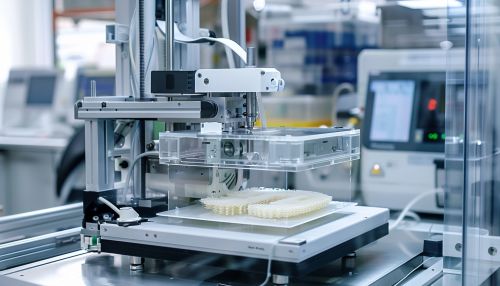Inkjet Bioprinting
Overview
Inkjet Bioprinting is a technology that uses bioprinters to deposit cells, biomaterials, and supporting components layer by layer to build tissue-like structures. This technology is a subset of 3D Bioprinting, which is a broader field that includes other techniques such as extrusion and laser-assisted bioprinting. Inkjet bioprinting is often used in Tissue Engineering and Regenerative Medicine due to its precision, scalability, and versatility.


History
The concept of inkjet bioprinting was first introduced in the late 1980s, when researchers began exploring the possibility of using inkjet technology for biological applications. The first successful experiments were conducted in the early 2000s, when scientists managed to print living cells using modified inkjet printers. Since then, the field of inkjet bioprinting has grown rapidly, with numerous advancements in both technology and applications.
Principles and Techniques
Inkjet bioprinting operates on the same basic principles as traditional inkjet printing. The bioprinter is loaded with a 'bioink' – a solution containing living cells and other necessary components. This bioink is then deposited onto a substrate or 'build platform' in a pre-determined pattern. The bioink droplets are typically in the picoliter to nanoliter range, allowing for high-resolution printing.
There are two main types of inkjet bioprinting: thermal and piezoelectric. Thermal inkjet bioprinting uses heat to create a bubble in the ink chamber, which forces a droplet of bioink out of the nozzle. Piezoelectric inkjet bioprinting, on the other hand, uses a piezoelectric crystal that deforms when an electric current is applied, pushing the bioink out of the nozzle.
Applications
Inkjet bioprinting has a wide range of applications in the field of biomedicine. One of the most promising areas is tissue engineering, where it is used to create complex tissue constructs for transplantation or drug testing. It is also used in regenerative medicine, where it can be used to print cells directly onto wound sites to promote healing. Other applications include disease modeling, pharmaceutical testing, and basic biological research.
Challenges and Future Directions
Despite its potential, inkjet bioprinting faces several challenges. One of the main issues is the survival and function of the printed cells, which can be affected by the printing process. Other challenges include the development of suitable bioinks, the creation of complex multi-cellular structures, and the vascularization of printed tissues.
The future of inkjet bioprinting looks promising, with ongoing research aimed at overcoming these challenges. Advances in materials science are leading to the development of new bioinks, while improvements in printer technology are enabling the creation of more complex and functional tissues. In addition, the integration of inkjet bioprinting with other technologies, such as microfluidics and nanotechnology, is opening up new possibilities for tissue engineering and regenerative medicine.
